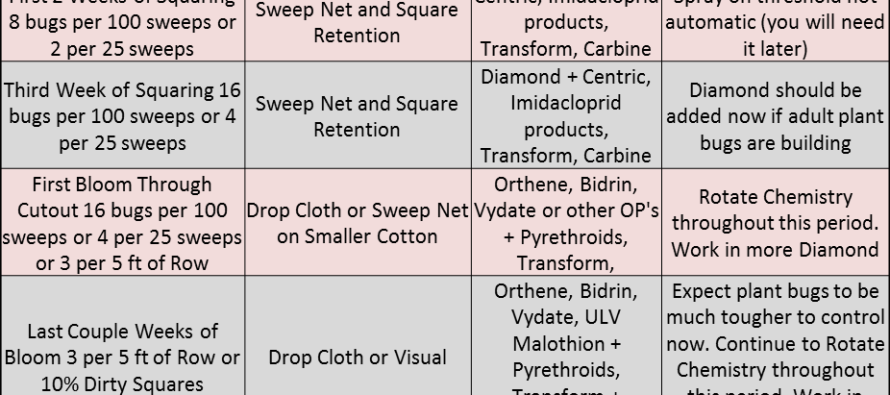Plant Bugs Moving Into Squaring Cotton

In the last 7 days we have received a number of calls about adult plant bugs beginning to move into squaring cotton. In many cases, fields that were treated last week have higher or equal numbers this week. As we move quickly toward bloom it is critical to take square retention, if for no other reason than to allow you to evaluate the performance of the material you are applying.
Applications prior to bloom are generally targeted at adult plant bug populations. They begin to move rapidly into fields from alternate hosts as they dry down or become less attractive. A common reaction to increasing numbers from one check to the next is an insecticide failure. In fact, this may not be the case at all. In high pressure situations where we get heavy adult movement into fields over a several week period there is no insecticide that will provide over 7 day residual on adult plant bugs and 5 days will be stretch. Remember, residual control is not 14 days when you make an application and it is 14 days until the next population moves into a field. Residual control of 14 days is when you make and application and it controls insects moving into the field for 14 days.
So how do you know if the products are working at all then?
The answer is square retention counts. If you monitor square retention every time you check a field you will have a much better indication of product performance than relying on bug numbers alone this time of year. This is because if adult plant bug number continues to move into the field and square retention stays relatively the same on your next check, your product is still holding. However, if you make an application and 4 days later square retention drops 10% that is a strong indication that your product is not preforming or able to hold up under the pressure. Be realistic with square retention, 85% is a good number to shoot for and if you drop below 80% you need to tighten your spray intervals.
How do you take square retention?
Square retention is a critical component of early season plant bug management. I would strongly encourage you to take square retention counts along with your sweep net counts prior to bloom. Not only does this help in the decision making process of treating plant bugs, but it also helps you to get a better idea of how the products you are applying are working. Numbers alone can be deceiving when adults are steady moving into the field. When large numbers of adults are migrating into a field it is not uncommon to have as many or more plant bugs 4-5 days after a spray than you did before you sprayed.
Square retention counts are extremely easy and fast to do. There are numerous ways to do it but this is the method that we prefer: Get a clicker or keep up with this in your head. Look at first position squares starting at the terminal going down the plant. I would not spend a lot of time in the terminal digging for tiny pinhead squares but look at the first square you can easily find (usually between pinhead and match head size). Starting there, count down 3 first position squares (some people do 5 positions down) and move to the next plant keeping up with how many squares you have looked at by clicking every time you look at a first position square. Any time you see a position that is missing, blasted, or flared keep up with that number separately in your head because it will be a smaller number. If the plants are small and only have 1 or 2 first positions only count those and move to the next plant. If it has more than 3, that’s fine also but stop counting there and move to next plant. Do this in several places in the field until you have looked at 100 first position fruiting sites regardless of the total number of plants it takes you to get to 100. Example: You have looked at 100 first position fruiting sites and have 15 missing sites you are at 85% square retention. You will be very surprised at how fast you can do this, especially if you use a clicker. Another reason that this is important is that you if square retentions starts dropping below 80%, you may have to adjust your threshold down to start hanging more first position fruit. For example: Let’s say we are in the first two weeks of square set (the threshold is 8/100 sweeps) and my square retention is 70% but I am only catching 5-6/100 sweeps I would consider treating the field based on the poor square retention although numbers are not quite at threshold. Please call if you have any questions about this.
Top 3 First Position Squares From Terminal Down
Thresholds, Sampling, and Product Choices
The table below is certainly not all inclusive of available options but is intended to give some examples of how management decisions should change across the course of the season for tarnished plant bugs. Also keep in mind that you may not be making applications during all of these periods.
Click on to Enlarge








Let me tell You a sad story ! There are no comments yet, but You can be first one to comment this article.
Write a comment